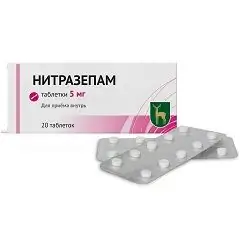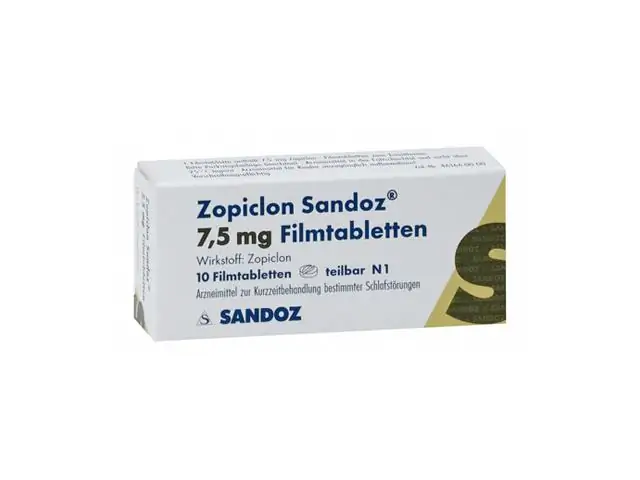Nitrazepam
Nitrazepam: instructions for use and reviews
- 1. Release form and composition
- 2. Pharmacological properties
- 3. Indications for use
- 4. Contraindications
- 5. Method of application and dosage
- 6. Side effects
- 7. Overdose
- 8. Special instructions
- 9. Application during pregnancy and lactation
- 10. Use in childhood
- 11. In case of impaired renal function
- 12. For violations of liver function
- 13. Use in the elderly
- 14. Drug interactions
- 15. Analogs
- 16. Terms and conditions of storage
- 17. Terms of dispensing from pharmacies
- 18. Reviews
- 19. Price in pharmacies
Latin name: Nitrazepam
ATX code: N05CD02
Active ingredient: nitrazepam (nitrazepam)
Producer: Altai Federal Research and Production Center (Russia), Moscow Endocrine Plant FSUE (Russia)
Description and photo update: 01.10.2019

Nitrazepam is a potent hypnotic drug from the benzodiazepine group with anxiolytic, anticonvulsant, sedative and muscle relaxant effects.
Release form and composition
Dosage form - tablets: flat-cylindrical or spherical, white with a yellowish-greenish tint, with a bevel (10 pcs. In a blister strip, in a cardboard box 1, 2 or 5 packages; 20 or 50 pcs. In a polymer can or from light-shielding glass, in a pack of cardboard 1 can and instructions for the use of Nitrazepam).
Active ingredient: nitrazepam, its content in 1 tablet is 5 mg.
Additional components: low molecular weight medical polyvinylpyrrolidone (povidone), milk sugar (lactose), talc, primogel (sodium carboxymethyl starch), potato starch, magnesium stearate.
Pharmacological properties
Pharmacodynamics
Nitrazepam is a hypnotic drug of the benzodiazepine group. Also, the drug has a central muscle relaxant, anticonvulsant and anxiolytic effect.
The main mechanism of hypnotic action is based on the inhibition of cells of the reticular formation of the brain stem. Under the influence of nitrazepam, the duration and depth of sleep increases. Sleep and awakening are physiological.
Nitrazepam enhances the inhibitory effect of GABA (gamma-aminobutyric acid), which is one of the main mediators of pre- and postsynaptic inhibition of impulse transmission in the central nervous system. Reduces the excitability of the subcortical structures of the brain (limbic system, thalamus, hypothalamus), inhibits polysynaptic spinal reflexes. Reduces the influence of emotional, motor and autonomic stimuli that disrupt the mechanism of falling asleep.
The anxiolytic effect of nitrazepam is due to the effect on the amygdala complex of the limbic system. It manifests itself in a decrease in emotional stress, a weakening of fear, anxiety, anxiety.
Sedation is based on the effect on the reticular formation of the brainstem and nonspecific nuclei of the thalamus. This property of the drug manifests itself in the form of a decrease in the symptoms of neurotic origin (fear, anxiety).
The anticonvulsant effect of nitrazepam is provided by increased presynaptic inhibition. The substance suppresses the spread of epileptogenic activity, while the excited state of the focus is not removed.
The central muscle relaxant effect is based on inhibition of polysynaptic spinal afferent inhibitory pathways. Direct inhibition of muscle and motor nerve function is also possible.
The development of the therapeutic effect is noted 30 minutes after oral administration, its duration varies from 6 to 8 hours.
Pharmacokinetics
Absorption of nitrazepam from the gastrointestinal tract is complete and rapid. Bioavailability is 54–98% (depending on the dosage form). If taken simultaneously with food, absorption is slowed down, while the maximum plasma concentration decreases by approximately 30%.
The average value of the maximum concentration with a single oral administration of 10 mg of the substance is from 0.08 to 0.1 μg / ml, the time to reach it is 1–4 hours. The connection with plasma proteins is approximately 85–90%.
The distribution phase of nitrazepam in the body varies greatly and can be 1.7-3.5 hours. With age, the volume of distribution increases, this figure is 1.3–2.6 l / kg. It penetrates well through histohematogenous barriers, including the blood-brain and placental barriers, and is found in mother's milk.
Metabolism occurs in the liver by reduction of the nitro group and subsequent acetylation with the formation of inactive acetyl derivatives.
The half-life is 16–48 hours (the value of this indicator is determined by age and body weight), from cerebrospinal fluid - 68 hours.
The main metabolites are: 7-acetamino-nitrazepam, 7-amino-nitrazepam, 2-amino-5-nitrobenzophenone and hydroxy-2-amino-5-nitrobenzophenone. They are excreted in the urine and feces (65–71% and 14–20%, respectively). Approximately 1–5% of the dose is excreted unchanged by the kidneys.
With repeated administration, there is a minimal accumulation of the substance (nitrazepam refers to benzodiazepines with a short / medium half-life), after cessation of treatment, excretion is rapid.
Indications for use
- Sleep disorders of various origins (difficulty falling asleep, frequent nocturnal and / or early morning awakenings);
- Somnambulism;
- Several forms of seizures, including West syndrome (fulminant nodding seizures) in young children;
- Organic lesions of the central nervous system (circulatory disorders of the brain, the consequences of traumatic brain injury);
- Neuroses;
- Affective insanity;
- Mental disorders, accompanied by an increased sense of anxiety and anxiety;
- Encephalopathy with epileptic manifestations;
- Withdrawal symptoms in alcoholism and drug addiction;
- Schizophrenia (as part of combination therapy).
Contraindications
Absolute:
- Severe depression;
- Acute respiratory failure;
- Drug or alcohol dependence;
- Addiction;
- Acute alcohol intoxication, accompanied by a weakening of vital functions;
- Temporal lobe epilepsy;
- Closed-angle glaucoma;
- Coma;
- Shock;
- Myasthenia gravis;
- Hypercapnia;
- Severe chronic obstructive pulmonary disease;
- Acute intoxication with drugs that have a depressing effect on the central nervous system;
- Swallowing disorders in children;
- Pregnancy and lactation period;
- Hypersensitivity to the components of the drug or other benzodiazepines.
Relative:
- Respiratory failure;
- Hyperkinesis;
- Cerebral and spinal ataxias;
- Hepatic and / or renal failure;
- Organic brain diseases;
- Sleep apnea (including suspected sleep apnea);
- Hypoproteinemia;
- Ataxia;
- Psychosis;
- Propensity to abuse psychoactive drugs;
- A history of drug dependence;
- Elderly age.
Nitrazepam, instructions for use: method and dosage
Nitrazepam tablets should be taken orally.
As a sleeping pill for sleep disorders - 1 time per day 30 minutes before bedtime. Recommended doses:
- Children under 1 year old - 1.25-2.5 mg;
- Children 1-5 years old - 2.5-5 mg;
- Children 6-14 years old - 5 mg;
- Adolescents over 14 years of age and adults - 5-10 mg, the maximum permissible daily dose is 20 mg;
- Elderly people (over 65 years old) - 2.5-5 mg.
Recommended doses when using Nitrazepam as an anticonvulsant and anxiolytic drug:
- Adults - 5-10 mg 2-3 times a day;
- Elderly patients - 2.5-5 mg 2-3 times a day;
- Children 6-14 years old - 7.5-15 mg (daily dose) in 3 divided doses;
- Children 1-6 years old - 5-10 mg (daily dose) in 3 divided doses;
- Children under 1 year old - 2.5-7.5 mg (daily dose) in 3 divided doses.
2/3 of the daily dose is recommended to be taken at night.
When calculating the infant dose of nitrazepam, it is recommended to take body weight into account. For children weighing up to 30 kg, 0.3-1 mg / kg / day is prescribed in 3 divided doses.
With West syndrome in children aged 1 to 2 years, 2.5-5 mg per day in 1 dose is prescribed.
For infants and children who cannot swallow the tablet whole, an appropriate amount of the drug can be crushed and dissolved (suspended) in a small amount of water.
The duration of treatment is usually 30-45 days.
All of the above doses are indicative. In each case, the doctor determines the optimal dose individually, depending on the indication, general condition of the patient, etiopathogenesis and individual tolerance of the drug.
Side effects
- Nervous system: at the beginning of treatment (especially in the elderly) - decreased concentration, mental and motor reactions slowdown, dizziness, fatigue, dullness of emotions, drowsiness, lethargy, ataxia; rarely - confusion, euphoria, catalepsy, headache, dystonic extrapyramidal reactions (uncontrolled body movements, including the eyes), blurred speech, depression, anterograde amnesia, dysarthria, muscle weakness, tremor; in some cases - paradoxical reactions (psychomotor agitation, anxiety, fear, insomnia, aggressive outbursts, increased irritability, hallucinations, muscle spasms, suicidal tendencies);
- Digestive system: drooling or dry mouth, decreased or increased appetite, nausea, vomiting, diarrhea / constipation, jaundice, increased activity of hepatic transaminases and alkaline phosphatase, liver dysfunction;
- Genitourinary system: urinary incontinence or retention, increased or decreased libido, impaired renal function, dysmenorrhea;
- Hematopoietic organs: anemia, neutropenia, leukopenia, thrombocytopenia, agranulocytosis (unusual fatigue or weakness, sore throat, hyperthermia, chills);
- Cardiovascular system: lowering blood pressure; rarely - tachycardia;
- Allergic reactions: itching, skin rash;
- Others: addiction, drug dependence; rarely - weight loss, bulimia, visual impairment (diplopia), depression of the respiratory center.
With a sharp dose reduction or discontinuation of Nitrazepam, a withdrawal syndrome may develop, manifested by the following symptoms: psychomotor agitation, anxiety, fear, increased irritability, depersonalization, dysphoria, tremor, sleep disturbance, headache, perception disorders (including paresthesia, hyperesthesia, hyperacusis, photophobia), depression, hallucinations, increased sweating, tachycardia, nausea, vomiting, spasm of smooth muscles of internal organs and skeletal muscles, convulsions; rarely - acute psychosis.
In newborns, whose mothers took Nitrazepam during pregnancy, suppression of the sucking reflex, respiratory failure and depression of the central nervous system are possible.
Overdose
The main symptoms: decreased reflexes, paradoxical agitation, drowsiness, ataxia, dysarthria, depression of consciousness of varying severity (up to coma), decreased response to pain irritation, deep sleep, severe weakness, nystagmus (visual impairment), tremor, shortness of breath or shortness of breath, bradycardia, lowering blood pressure, depression of respiratory and cardiac activity, collapse.
Therapy: gastric lavage, activated charcoal intake, forced diuresis, symptomatic treatment (aimed at maintaining breathing and blood pressure) are prescribed. Flumazenil is used as a specific antagonist in a hospital setting. Hemodialysis is ineffective.
special instructions
Care should be taken to begin treatment of patients who, prior to the appointment of nitrazepam, were undergoing therapy with any other drug for a long time.
Patients with severe depression should be under special supervision during the treatment period, since they can use the drug to implement suicidal intentions.
Nitrazepam should not be taken for a long time without a doctor's prescription.
During therapy, it is strictly forbidden to consume alcohol, you should refrain from driving a car and performing potentially hazardous types of work that require a high reaction rate and increased attention.
With long-term treatment, as well as in patients with renal and / or hepatic insufficiency, it is necessary to control liver enzymes and a picture of peripheral blood.
Nitrazepam has a primary addictive potential. The risk of drug dependence formation increases in patients who have previously abused drugs or alcohol, as well as when the drug is used in high doses or for a long time, even at usual therapeutic doses. For this reason, the doctor prescribes this remedy individually after a careful assessment of the benefits and the possible risk of developing addiction or dependence.
To avoid the development of a withdrawal syndrome, treatment should not be stopped abruptly; the dose should be gradually reduced.
The drug must be canceled in case of the development of paradoxical reactions such as hallucinations, superficial sleep, difficulty falling asleep, psychomotor agitation, increased muscle cramps, fear, aggressiveness, suicidal thoughts.
In the case of frequent use of the drug during pregnancy, there is a risk of developing physical dependence (withdrawal syndrome) in a newborn.
Taking Nitrazepam immediately before childbirth or during childbirth can cause a weak suckling act in a newborn ("flaccid baby syndrome"), decreased muscle tone and blood pressure, hypothermia, and respiratory depression.
In young children, there is an increased production of sputum and mucus in the respiratory tract, therefore, measures must be taken to ensure good airway patency.
Influence on the ability to drive vehicles and complex mechanisms
Patients during the period of Nitrazepam therapy should refrain from driving vehicles and complex mechanisms.
Application during pregnancy and lactation
Nitrazepam is not prescribed during pregnancy / lactation.
Pediatric use
If swallowing is impaired in children, therapy is contraindicated.
With impaired renal function
Nitrazepam is used with caution in patients with renal insufficiency.
For violations of liver function
Nitrazepam is used with caution in patients with hepatic impairment.
Use in the elderly
The use of the drug in elderly patients requires medical supervision.
Drug interactions
Inducers of microsomal liver enzymes reduce the effectiveness of nitrazepam, oral estrogen-containing contraceptives and cimetidine - enhance and lengthen.
Mutual enhancement of action is noted when Nitrazepam is combined with psychotropic and anticonvulsants, general anesthetics, narcotic analgesics, muscle relaxants, lithium preparations, antihistamines and sedatives, anxiolytics, barbiturates, clonidine and ethanol.
Narcotic analgesics taken simultaneously increase the euphoria and lead to an increase in drug dependence.
Nitrazepam reduces the effectiveness of levodopa, may increase the toxicity of zidovudine.
In the case of the simultaneous use of clozapine, respiratory depression is possible, antihypertensive drugs - a pronounced decrease in blood pressure.
Microsomal oxidation inhibitors lengthen the half-life of nitrazepam and increase the risk of developing its toxic effects.
Valproic acid is likely to enhance the effect of nitrazepam in children with epilepsy.
Probenecid and cimetidine slow down the excretion of nitrazepam, as a result of which the substance accumulates in the body, which leads to excessive sedation.
Rifampicin enhances the excretion of nitrazepam.
Analogs
Analogs of Nitrazepam are: Nitrosan, Radedorm 5, Eunoktin.
Terms and conditions of storage
Store in a place protected from light and moisture, out of reach of children, at temperatures up to 25 ºС.
The shelf life is 3 years.
Terms of dispensing from pharmacies
Dispensed by prescription.
Reviews of Nitrazepam
Reviews of Nitrazepam are few. Most of them indicate the effectiveness of the drug and its good tolerance. At the same time, it is noted that the development of addiction is possible.
Price for Nitrazepam in pharmacies
The approximate price for Nitrazepam (20 tablets) is 37 rubles.

Anna Kozlova Medical journalist About the author
Education: Rostov State Medical University, specialty "General Medicine".
Information about the drug is generalized, provided for informational purposes only and does not replace the official instructions. Self-medication is hazardous to health!







